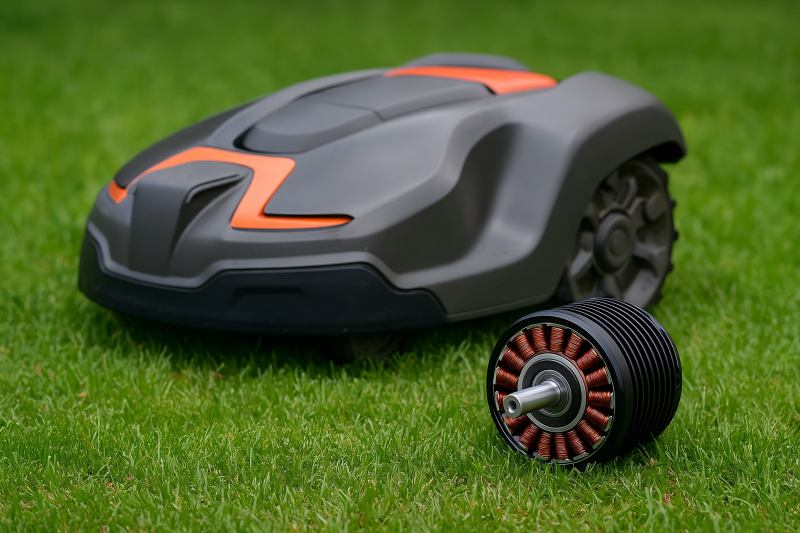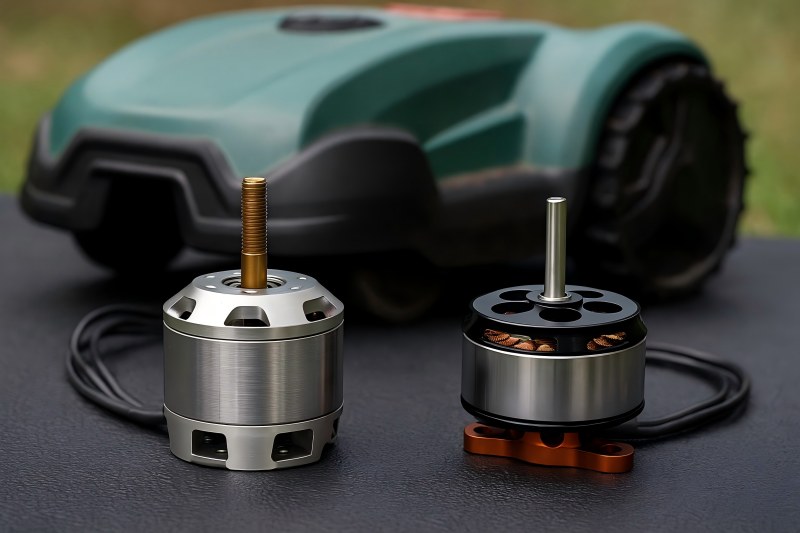Importance of Motors in Robotic Lawn Mowers
The motor is the heart of every robotic lawn mower. It converts electrical energy into mechanical motion, driving both the cutting blades and the wheels that move the mower across the lawn. With the rise of smart home automation and autonomous outdoor robots, motor performance has become a defining factor for cutting quality, runtime, and reliability.
Traditional brushed DC motors once dominated small robotics, but their limited lifespan, brush wear, and energy losses made them unsuitable for modern robotic mowers. BLDC motors offer efficiency, quiet operation, and minimal maintenance. These motors use electronic commutation instead of brushes, eliminating frictional losses and extending operational life — essential for outdoor robots that must endure long mowing cycles under varying loads.
Among mower electric motor designs, Inrunner and Outrunner motors represent two distinct structural types. Both use the same electromagnetic principles but differ in rotor placement and performance characteristics. Choosing between them can determine whether a mower runs smoothly over uneven terrain, manages wet grass effectively, or drains its battery prematurely.

Motor Requirements for Robotic Lawn Mowers
A robotic lawn mower’s operational environment is demanding. It must handle tall or damp grass, operate quietly, and traverse slopes while consuming as little energy as possible.
These conditions create specific performance requirements for its motors.
High Torque at Low Speeds
The drive system needs torque to propel the mower through thick or wet grass, especially when ascending slopes or maneuvering on uneven terrain.
Stable RPM and Smooth Operation
The blade motor must maintain a consistent cutting speed, typically between 3,000 and 4,000 RPM, to ensure even trimming and avoid grass tearing.
Energy Efficiency
Since robotic mowers rely on batteries, the motors must operate efficiently to maximize runtime before recharging.
Quiet Performance
Noise reduction is vital for consumer comfort and compliance with residential sound standards.
Durability and Weather Resistance
Motors must endure dust, moisture, and temperature fluctuations outdoors.
Compact Integration
The motor’s size and weight directly affect the robot’s balance, maneuverability, and total power-to-weight ratio.
These criteria influence whether an inrunner or outrunner configuration is more suitable for each function within the mower.

Pros and Cons of Internal Rotors in Robotic Lawn Mowers
Inrunner BLDC motors feature a rotating inner rotor surrounded by a stationary stator. Their cylindrical structure is compact and mechanically robust, allowing for high rotational speeds and precise control.
Advantages
High Speed Performance
Inrunner motors are optimized for high RPM, often exceeding 10,000 revolutions per minute. This makes them ideal for cutting blades, where high-speed rotation translates into a clean, efficient cut.
Compact Design
Their smaller diameter and enclosed rotor allow easier integration into tight spaces — suitable for smaller robotic platforms.
Precision Control
The rotor’s low inertia enables rapid acceleration and deceleration, supporting precise speed regulation.
Effective Sealing Against Debris
Because the rotor is internal, these motors can be sealed more effectively against dust, moisture, and grass clippings — a valuable feature for outdoor use.
Low Maintenance and Long Life
No brushes mean reduced wear, and their rigid internal design protects internal components during long mowing sessions.
Disadvantages
Low Torque Output
The small rotor radius limits torque generation, requiring additional gear reduction for wheel drive applications.
Cooling Challenges
The rotor’s position inside the stator makes it harder to dissipate heat. This can affect performance during long or heavy mowing sessions unless auxiliary cooling is used.
Higher Cost and Complexity
Achieving sufficient torque often requires precision gearboxes, increasing system cost and mechanical complexity.
Less Energy-Efficient at Low Speeds
Their efficiency peaks at high RPMs, making them less suitable for slow, continuous wheel motion.
In short, inrunner motors shine when used for blade rotation or compact auxiliary mechanisms, but they are not always the best choice for drive systems where torque is critical.
Pros and Cons of External Rotors in Robotic Lawn Mowers
Outrunner BLDC motors reverse the inrunner’s structure: the rotor is on the outside, rotating around the internal stator. This design provides a larger diameter and a longer magnetic path, directly enhancing torque output — a major benefit for propulsion.
Advantages
High Torque at Low RPM
The larger rotor radius and magnetic leverage deliver high torque without requiring complex gear reduction systems, ideal for wheel drive motors.
Natural Air Cooling
Because the rotor spins externally, it helps dissipate heat effectively, maintaining stable operation in outdoor environments.
Efficient for Continuous Low-Speed Operation
Outrunner motors maintain strong efficiency even at lower speeds, extending battery runtime during long mowing cycles.
Smooth Motion and Strong Start-Up Power
They provide stable rotational force even under variable load conditions such as dense or uneven grass.
Simpler Design, Lower Maintenance
Without additional gearing, outrunners can be directly coupled to wheels or blades, reducing mechanical losses.
Disadvantages
Larger Size and Weight
Their larger diameter can make compact mower designs more difficult, especially for multi-rotor configurations.
Exposure to Debris
Because the outer rotor spins externally, more care is needed in sealing against grass particles or dust ingress.
Reduced Maximum RPM
Outrunners typically operate below 6,000 RPM, making them less efficient for fast-rotating cutting blades unless optimized.
Inertia Effects
The heavier outer rotor increases rotational inertia, slowing rapid speed changes or braking response.
Despite these trade-offs, the outrunner design offers superior torque, durability, and cooling for traction systems, making it the preferred choice for the propulsion side of robotic lawn mowers.
Inrunner vs Outrunner Motor Comparison Table
| Feature | Inrunner BLDC Motor | Outrunner BLDC Motor |
| Rotor Position | Inside the stator | Outside the stator |
| Torque Output | Moderate to low | High |
| Speed Range | High RPM (10,000+) | Low-to-medium RPM (2,000–6,000) |
| Efficiency Range | Best at high speed | Best at low-to-mid speed |
| Cooling | Internal, less effective | Natural air cooling |
| Noise Level | Slightly higher | Lower, smoother rotation |
| Size & Weight | Smaller diameter, lighter | Larger diameter, heavier |
| Application Suitability | Blade motors, compact tools | Drive motors, load applications |
| Maintenance | Minimal | Minimal, but requires sealing |
| Control Precision | Excellent | Moderate |
| Cost Level | Slightly higher (gearbox required) | Lower (direct drive capable) |
The table shows that inrunner motors favor compactness and speed, while outrunner motors dominate in torque and simplicity. In practice, many robotic mower designs combine both — using inrunners for blades and outrunners for propulsion.
Case Studies and Industry Examples
Case Study 1: Compact Residential Robot Mower
A well-known European brand integrates inrunner BLDC motors for its cutting system. The blades rotate at over 4,000 RPM, powered by a 250W inrunner motor. Engineers selected this configuration due to its compactness, enabling a slimmer chassis design and quiet operation. However, for the drive wheels, the same model employs outrunner motors to deliver sufficient torque for 35° slope climbing capability.
Result: The dual-motor combination achieved a 25% longer runtime and 15% improved cutting uniformity compared to earlier brushed designs.
Case Study 2: Heavy-Duty Commercial Robot Mower
A large-scale robotic mower designed for golf courses or parks uses dual high-torque outrunner motors for both blade and drive systems. The motors operate at low RPM (under 5,000), ensuring quiet, continuous torque delivery with minimal mechanical loss.
Result: The mower can handle thick, damp grass and extended mowing sessions exceeding three hours without overheating. Despite its size, overall system efficiency improved by 18%, attributed to the outrunner’s natural air cooling and direct-drive simplicity.
These examples illustrate that the optimal configuration depends on scale and application. Compact residential models may favor mixed setups, while large professional mowers leverage outrunners for both power and endurance.
Matching Motor Types to Functions
Not all parts of a lawn mowing robot have identical performance requirements. Different subsystems demand different motor characteristics. The following table summarizes ideal pairings:
| Subsystem | Recommended Motor Type | Key Reason |
| Cutting Blades | Inrunner BLDC | High RPM enables fine, even grass cutting |
| Drive Wheels | Outrunner BLDC | High torque for traction and slope handling |
| Cooling Fans or Pumps | Inrunner BLDC | Compact, fast rotation, low inertia |
| Heavy-Duty Industrial Mowers | Outrunner BLDC | Direct-drive power and superior thermal stability |
Inrunner motors provide speed, precision, and sealing advantages for the blade system, where torque is less critical. Conversely, outrunner motors excel in the wheel drive, where torque, endurance, and smoothness are more important than maximum RPM.
A growing trend is hybrid motor integration, combining both motor types in a single mower design. The inrunner handles fast blade spinning, while the outrunner manages traction — creating a balance between cutting efficiency and maneuvering power.
Integrated Design Considerations
When integrating BLDC motors into robotic lawn mowers, engineers must consider more than just motor type. The entire electromechanical system — including cooling, control electronics, and mechanical mounting — influences performance and durability.
Thermal Management
- Outrunner motors naturally cool better due to their exposed rotor design.
- Inrunners may require dedicated heat sinks or airflow channels to maintain temperature stability during extended cutting.
Electronic Speed Control (ESC)
- ESC tuning must match the motor’s Kv rating (RPM per volt) and load profile.
- Inrunners require faster response controllers for blade RPM consistency, while outrunners benefit from torque-optimized current control.
Power and Battery Balance
- Motor efficiency directly affects runtime.
- Outrunners operating at low RPM often improve energy use during continuous mowing, extending battery life by up to 20%.
Environmental Protection
- Both motor types require IP-rated sealing to resist dust and grass debris.
- Inrunner enclosures are easier to waterproof, while outrunner systems often use protective housings or integrated shrouds.
Mounting and Space Optimization
- Inrunners fit best in compact vertical spaces (e.g., blade mounts).
- Outrunners may require wider chassis mounting but offer simplified direct-drive coupling.
Cost vs. Performance
- While inrunners often cost more due to gearbox needs, outrunners offer better value for torque-driven applications.
- Manufacturers frequently balance both within a single system to achieve an optimal price-performance ratio.
In the evolving world of robotic lawn mowers, both inrunner and outrunner BLDC motors play vital roles. The decision depends on the specific function and design goals of the mower.
- Inrunner BLDC motors deliver high rotational speed, compactness, and sealing advantages — ideal for blade cutting and compact auxiliary mechanisms.
- Outrunner BLDC motors provide the torque, cooling, and low-speed efficiency essential for propulsion and endurance.
For the best performance, many manufacturers now adopt dual motor configurations, combining an inrunner for blade rotation and an outrunner for traction. This hybrid approach maximizes energy efficiency, cutting precision, and terrain adaptability — defining the next generation of intelligent, autonomous lawn care robots.
